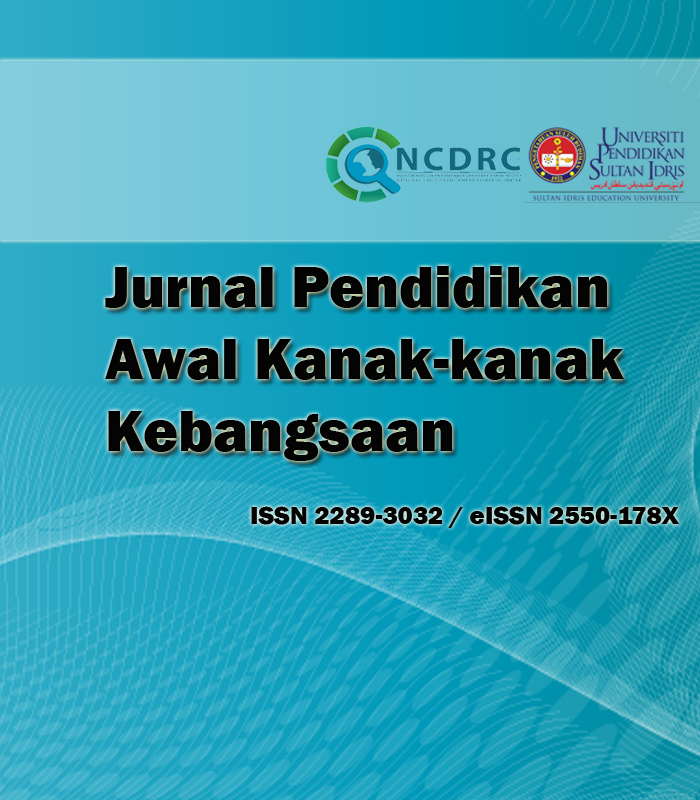Facilitating a Kindergarten Child to Make Sense of Number Pattern at Home: A Case study
DOI:
https://doi.org/10.37134/jpak.vol13.1.2.2024Keywords:
number pattern, early mathematic, home learningAbstract
This research aims to explore the mechanism of making sense number patterns at home, because of local pandemic COVID-19 outbreaks during the enforcing of the conditional motion control order (CMCO). The new mechanism framework is based on the blending of Skemp's understanding property, Tall’s idea of compression, and Chin's supportive and problematic conceptions framework. The researchers employed a qualitative case analysis study design, and a purposive sampling method was used to obtain a sample of one kindergarten child and one parent. Data were gathered in semi-structured parent interviews, direct observations, and analysis of documents such as worksheets and journal entries were performed to gain a comprehensive picture of a child’s making sense of number patterns. Results demonstrate that the mechanism was potential successful for helping the kindergarten child in making sense the number patterns. The child was able to make sense and recognise various number patterns at the end of this study.
Downloads
References
Biggs, N. (2016). Quite right: The story of mathematics, measurement, and money. Oxford University Press.
Boaler, J. (2015). Mathematical mindsets: Unleashing students' potential through creative math, inspiring messages and innovative teaching. John Wiley & Sons.
Chin, K. E. (2013). Making sense of mathematics: supportive and problematic conceptions with special reference to trigonometry (Unpublished doctoral thesis). Retrieved from http://wrap.warwick.ac.uk/58403/
Chin, K. E., Jiew, F. F., & Taliban, E. (2019). Conceptions in making sense of multiplication. EURASIA Journal of Mathematics, Science and Technology Education, 15(12). https://doi.org/10.29333/ejmste/105480
Chinn, S., & Ashcroft, R. E. (2017). Mathematics for dyslexics and Dyscalculics: A teaching handbook. John Wiley & Sons.
Clarke, V., & Braun, V. (2013). Teaching thematic analysis: Overcoming challenges and developing strategies for effective learning. The Psychologists, 62 (2), 120–123. http://eprints.uwe.ac.uk/21155/3/Teaching%20thematic%20analysis%20Research%20Repository%20version.pdf
Clements, D. H., & Sarama, J. (2014). Learning and teaching early math: The learning trajectories approach. Routledge.
Cotton, T. (2021). Understanding and teaching primary mathematics (4th ed.). Routledge.
Knaus, M., & Featherstone, S. (2015). Maths is all around you. Bloomsbury Publishing.
Kennison, S. M. (2018). Psychology of language: Theory and applications. Bloomsbury Publishing.
Lucangeli, D. (2020). Understanding dyscalculia: A guide to symptoms, management and treatment. Routledge.
Merriam, S. B., & Tisdell, E. J. (2016). Qualitative research: A guide to design and implementation (4th ed.). Jossey-Bass.
Minetola, J. R., Ziegenfuss, R. G., & Chrisman, J. K. (2013). Teaching young children mathematics.
MOE (2020). Lanjutan Tempoh Penutupan Institusi Pendidikan Di Seluruh Negeri Sabah. https://www.moe.gov.my/muat-turun/kenyataan-media/km2020/3798-km-lanjutan-tutup-ip-sabah/file
MOH (2020). SOP AM PKPD NEGERI SABAH. http://covid-19.moh.gov.my/faqsop/sop-perintah-kawalan-pergerakan-pkp/02SOP_AM_PKPD_NEGERI_SABAH_kemaskini_16112020.pdf
National Council of Teachers of Mathematics (2009). Focus in High School Mathematics: Reasoning and Sense Making. Retrieved from https://www.nctm.org/Standards-and-Positions/Focus-in-High-School-Mathematics/
O’Leary, Z. (2014). The essential guide to doing your research project (2nd ed.). SAGE Publications
Piaget, J. (1952). The origin of intelligence in the child. Routledge. https://doi.org/10.1037/11494-000
Pólya, G. (1945). How to solve it: A new aspect of mathematical method.
Reys, R., Lindquist, M., Lambdin, D. V., Smith, N. L., Rogers, A., Cooke, A., Bennett, S., Ewing, B., & West, J. (2019). Helping children learn mathematics (3rd ed.). John Wiley & Sons.
Rivera, F. (2013). Teaching and Learning Patterns in School Mathematics Psychological and Pedagogical Considerations. Springer Netherlands.
Skemp, R. R. (2002). Mathematics in the primary school. Psychology Press.
Sousa, D. A. (2014). How the brain learns mathematics (2nd ed.). Corwin Press.
Tall, D. (2013). How humans learn to think mathematically: Exploring the three worlds of mathematics. Cambridge University Press.
Taylor, H., & Harris, A. (2014). Learning and teaching mathematics 0-8. Sage Publications.
Thiel, O., Severina, E., & Perry, B. (2020). Mathematics in Early Childhood:Research, Reflexive Practice and Innovative Pedagogy. Routledge.
Thurston, W. P. (1990). Mathematical Education, Notices of the American Mathematical Society, 37, 7, 844‐850.
Tucker, K. (2010). Mathematics through play in the early years. SAGE.
Yin, R. K. (2018). Case study research: design and methods (6th ed.). Sage Publication.
Downloads
Published
How to Cite
Issue
Section
License
Copyright (c) 2024 Sai Hoe Fu, Lung Lung Tiong , Wui Chung Chow , Lai Kwoon Leong , Munah Nasri

This work is licensed under a Creative Commons Attribution-NonCommercial-ShareAlike 4.0 International License.





